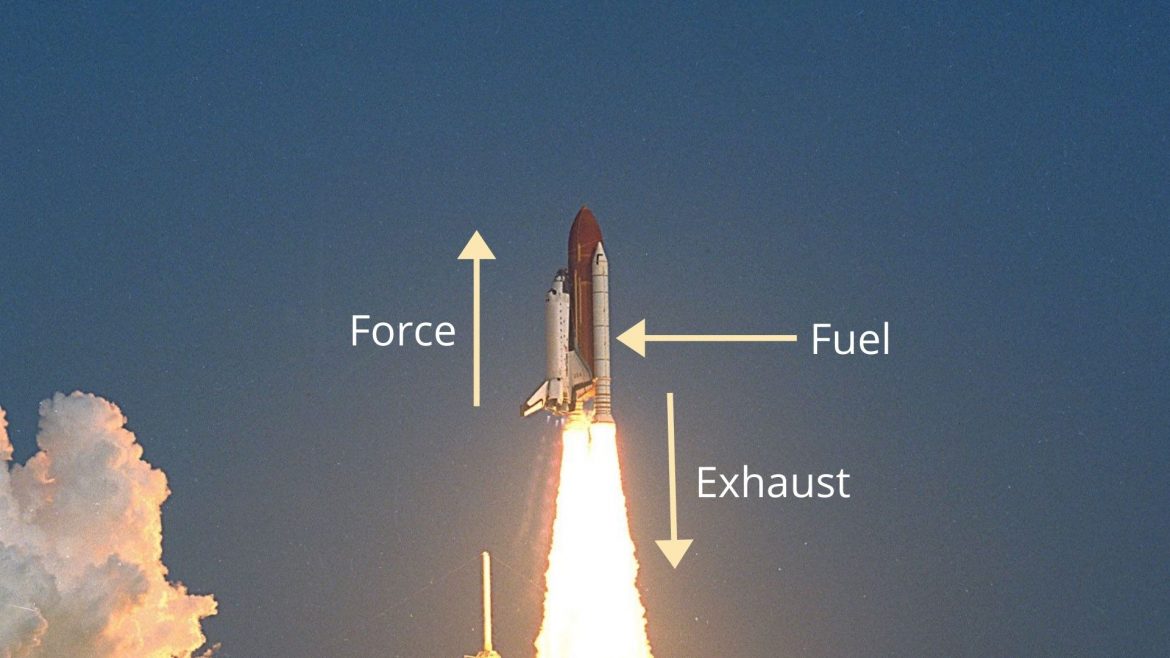Rockets can accelerate payloads fast and can send things into space, and you might have seen it from time to time. How does a rocket work? What is the physics behind it? Let’s find out in this article.
What’s Inside a Rocket?
To understand how a rocket works, we have to understand the interior of a rocket first. There is an important payload, and there is a lot of fuel inside the structure. The fuel with the oxidizer propels the rocket, and the rocket keeps getting lighter as the fuel is used bit by bit.
Of course, this would not be possible without rocket engines, which feed from the fuel. The more powerful the engines are and the more propellant the rocket carries, the more it accelerates before it runs out of supply.
How Does a Rocket Work?
Rockets rely on Newton’s third law of motion. When force is applied (the equal reaction), there must be an opposite reaction. This reaction exerts the same amount of force in the opposite direction. For instance, when a jet engine pushes air backward, the aircraft is pushed forward, maintaining the aircraft’s speed despite encountering air resistance. The more force the engines exert backward, the more it can accelerate.

Image Edited by Canva
Rockets work the same way too, but the direction is different. They go directly up, which means it applies a downward force. Keep in mind that rockets can work in outer space, too. Environmental molecules are not necessary for a rocket to propel itself forward as long as it can generate thrust.
How Does a Rocket Generate the Thrust?
A conventional rocket burns fuel to push itself upward, although experimental water rockets use the pressure to blast water onto the ground. By burning the fuel, the propellant explodes controllably, leading to an expansion. The only exit for the exhaust is the nozzle, so the fuel blasts backward, and the rocket is propelled forward. As the nozzle steers, the entire rocket changes direction too because the direction of the downward force is different.
Though only used for experimental purposes, we will still mention water rockets. The pressure in the structure wants it to expand in every direction. But the only exit is the bottom, right? Therefore, the water literally blasts the entire structure upward.
Saving Fuel and Equipment
Rockets, like other devices that use fuel, need to save fuel. This doesn’t only reduce the environmental damage but also lowers the cost. Therefore, drag reduction is necessary. Therefore, a nose cone exists for a typical rocket, whose shape reduces the air resistance when the rocket is still within the atmosphere.
Moreover, rockets eject parts or stages that have no fuel inside. For instance, the rocket boosters are ejected in-flight when the fuel inside runs out. This ensures that every single frame in the rocket is necessary to keep it working to reduce the mass of the payload the rocket needs to propel.
Furthermore, to reduce the cost of the production of rocket parts, reusable parts are often saved and used on the next mission. This is possible by landing systems such as parachutes and vehicles that capture them on their landings.
Conclusion
In this article, we briefly described how a rocket works. We did not cover launch procedures as the physics is the key. To learn more, please visit the websites in the references below.
References and Credits
- Tom Benson. (n.d.). Rocket Principles. Retrieved July 1, 2021, from https://www.grc.nasa.gov/www/k-12/rocket/TRCRocket/rocket_principles.html
- Tom Benson. (n.d.). Rocket Parts. Retrieved July 1, 2021, from https://www.grc.nasa.gov/www/k-12/rocket/rockpart.html
- Sandra May. (2011, July 13). What Is a Rocket? Retrieved July 1, 2021, from https://www.nasa.gov/audience/forstudents/k-4/stories/nasa-knows/what-is-a-rocket-k4.html
- Giles Sparrow. (2021, July 1). How rockets work: A complete guide | Space. Retrieved July 1, 2021, from https://www.space.com/how-rockets-work

